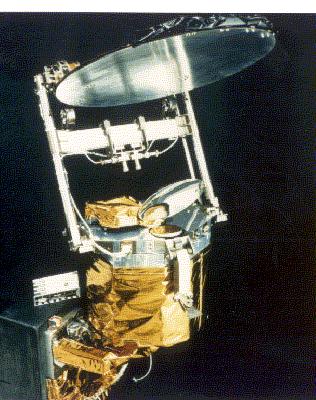
What better tide t’ introduce many o’ ye t’ passive microwave ocean products than on national Speak Like a Pirate Day?
I reckon well when I be jus’ a young researcher how I voyagened fer th’ launch o’ th’ first SSM/I (Special Sensor Microwave/Imager), which started providin’ data in th’ moon o’ July 1987.
‘t carried th’ first high frequency microwave channel, 85.5 GHz, thanks t’ Dick Savage, a student o’ Jim Weinman`s (UW-Madison). Dick an’ Jim had figured ou’ that microwave frequencies above 60 GHz ortin’ ta be able t’ observe “cold” (low-emissivity) microwave signatures from thunderstorms, snow, an’ other volume scatterers. An’ they be correct!
An’, aye, Dick Savage be as colorful as his name suggests.
Th’ SSM/I also had a better calibration design than th’ previous SMMR (Scannin’ Multichannel Microwave Radiometer) instrument, which provided sea ice data aft t’ 1979.
Thar would be a series o’ SSM/I`s, built by Hughes Aircraft, followed by th’ SSMIS`s built by Aerojet (aye, confusin’ names, I know). Most o’ th’ current sea ice products ye be seein’ on th’ web be from SSM/I an’ ’tis follow-on, th’ SSMIS.
Anyway, th’ “ocean product suite” o’ ocean surface winds an’ atmospheric vertically integrated water vapor, cloud water, an’ precipitation, ben produced by Frank Wentz an’ his mates at Remote Sensin’ Systems, in Santa Rosa, California. Sea surface temperatures would only be added in mid-2002 wi’ th’ low-frequency 6.9 GHz channel on AMSR-E, th’ instrument fer which I serve as th’ U.S. Science Team leader.
In me opinion, Frank has done more fer th’ interpretation o’ satellite passive microwave measurements than any other single swabbie in me business. He an’ I dasn’t always agree on science (or politics or religion), but he be a national booty in our research community, an’ I consider th’ lad’s a good matey.
I hope t’ start providin’ weekly updates o’ th’ RSS ocean products soon, in th’ form o’ departures from average conditions (anomalies) as well as th’ raw fields, so stay tuned, ya lily livered scallywags!

 Home/Blog
Home/Blog



